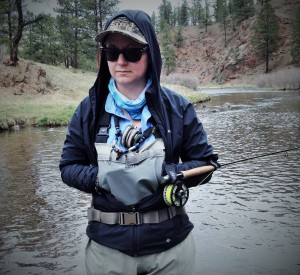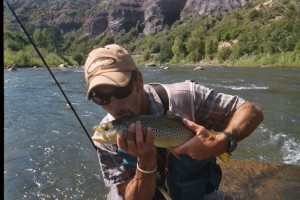Known for carving majestic canyons, millions of years ago the headwaters of the mighty Colorado River carved through the rocks west of Granby and created a small riparian valley where air currents blow through- earning a well-deserved name- Windy Gap. Although the wind continues to gust, the quality of the water has diminished over time.
In the 1980's, Windy Gap Reservoir was built directly inline with the river's east to west flow. Because of this placement, the river velocity drops as it enters the reservoir, resulting in increased sediment buildup. Currently, reservoir permits require building off channel to avoid the problems found in Windy Gap.
Because of the sediment build up, the Gold Medal status of the Colorado is in jeopardy. Over the years, as the sediment builds, Colorado Parks and Wildlife has seen a decrease in bug life and feeder fish. One of the feeder fish that has almost vanished in the river is Sculpin- a small fish species that not only do trout rely on, but the health of the river relies on too.
“We have looked and looked, but we do not find any sculpin in that section of the river, all the way to Gore Canyon," said Colorado Parks and Wildlife Aquatic Biologist John Ewitt to Sky-Hi Daily News in Grand County. Sculpin are sensitive to environmental impacts and the levels of sculpin are often used to gauge overall river health.
CPW has also noted a decrease in mayflies, caddisflies, and stoneflies- three of the main food sources for trout in the area.
But the solution to the problem is near. With help from Trout Unlimited and local organizations, a project to bypass the Windy Gap reservoir is in the works.
Over the last 15 years, Trout Unlimited and local landowners have been lobbying with Northern Water to find a solution to this problem. The groups became known as the Upper Colorado River Alliance (UCRA) and comprised the idea of bypassing the reservoir.
Northern Water was intrigued by the idea as they were looking for a similar way to expand their water storage capabilities. In a project they are calling the Windy Gap Firming Project (WGFP), they would build Chimney Hollow Reservoir to solve the storage problem. When Northern Water went to the Grand County government for a permit on Chimney Hollow, there was a condition for the Windy Gap bypass.
The long-term project will include digging a portion of Windy Gap and using the dirt to build a berm in the current reservoir to create a smaller, adjacent body of water. This will create a new channel for the Colorado River to flow through. Preliminary engineering is expected to be completed this summer.
The total price for the project will be around $9.6 million- and a little under half of that, 4.1 million, has already been secured for the project. Along with $2 million towards the project, Northern Water has contributed around $300,000 towards environmental studies below the reservoir. The state of Colorado has also contributed $2 million to the project.
The Colorado River Headwaters chapter of Colorado TU has been on the forefront of this problem and has been a major part in helping get the bypass underway. With more help from volunteers and members, the bypass can be completed and the 20 miles of Gold Medal waters along the Colorado can thrive.









 great way to save money. And like most things, the correct answer is, "It depends." The initial cost of purchasing the tools and materials can range anywhere from $50-200+ but, again, this depends on the quality and quantity of materials.
great way to save money. And like most things, the correct answer is, "It depends." The initial cost of purchasing the tools and materials can range anywhere from $50-200+ but, again, this depends on the quality and quantity of materials. portsman Bumper-
portsman Bumper- RodCuffs
RodCuffs Fishpond Boat Caddie
Fishpond Boat Caddie




 Mining Law.
Mining Law. notable spill, the same tragedies are happening throughout the west. The Uncompahgre River near Ouray is lifeless until the metals fall into the depths of Ridgeway Reservoir. The upper Animas River suffers mine waste that steadily drains into the river at a volume equal that of the Gold King Mine spill once a week.
notable spill, the same tragedies are happening throughout the west. The Uncompahgre River near Ouray is lifeless until the metals fall into the depths of Ridgeway Reservoir. The upper Animas River suffers mine waste that steadily drains into the river at a volume equal that of the Gold King Mine spill once a week.
 - Beyond being an awesome angler, what else do you do in your spare time or for work?
I’m semi-retired, still working a couple of days per week as an allergy and asthma doctor in a practice I’ve been devoted to for over 25 years. I love to hunt elk, deer, and pheasant. I also play drums with a weekly jazz group, cycle regularly, and still cut my lawn and own several chainsaws to keep in shape.
- Beyond being an awesome angler, what else do you do in your spare time or for work?
I’m semi-retired, still working a couple of days per week as an allergy and asthma doctor in a practice I’ve been devoted to for over 25 years. I love to hunt elk, deer, and pheasant. I also play drums with a weekly jazz group, cycle regularly, and still cut my lawn and own several chainsaws to keep in shape.





